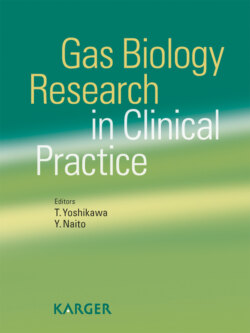Читать книгу Gas Biology Research in Clinical Practice - Группа авторов - Страница 35
На сайте Литреса книга снята с продажи.
Carbon Monoxide
ОглавлениеCarbon monoxide (CO) is an invisible, chemically inert, colorless and odorless gas and is commonly viewed as an environmental pollutant associated with toxic effects resulting from its ability to compete with oxygen for binding to hemoglobin. CO avidly binds to hemoglobin and forms carboxyhemoglobin (COHb) with an affinity 240 times higher than that of oxygen, resulting in interference with the oxygen-carrying capacity of the blood and consequent tissue hypoxia. Recent basic research has revealed that endogenous CO is an important physiological regulatory factor and exerts anti-inflammatory, anti-apoptotic and organ/cellular protective effects. CO is endogenously and physiologically generated in mammalian cells via the catabolism of heme in the rate-limiting step by heme oxygenase (HO) systems [9]. Potent therapeutic efficacies of CO have been demonstrated using experimental models for many conditions, including paralytic ileus, hemorrhagic shock [10], hyperoxic lung injury, and endotoxemia, supporting the new paradigm that, at low concentrations, CO functions as a signaling molecule that exerts significant cytoprotection. Similarly, bacteria are associated with at least one-third of COPD exacerbations. Toll-like receptors (TLRs) are needed for recognition and clearance of bacteria. In macrophages, CO has recently been shown to inhibit signaling by TLR2, TLR4, TLR5 and TLR9 (but not TLR3) [11]. Soluble forms of CO, such as CO-releasing molecules, may overcome the problem of toxicity and allow clinical application [2].
